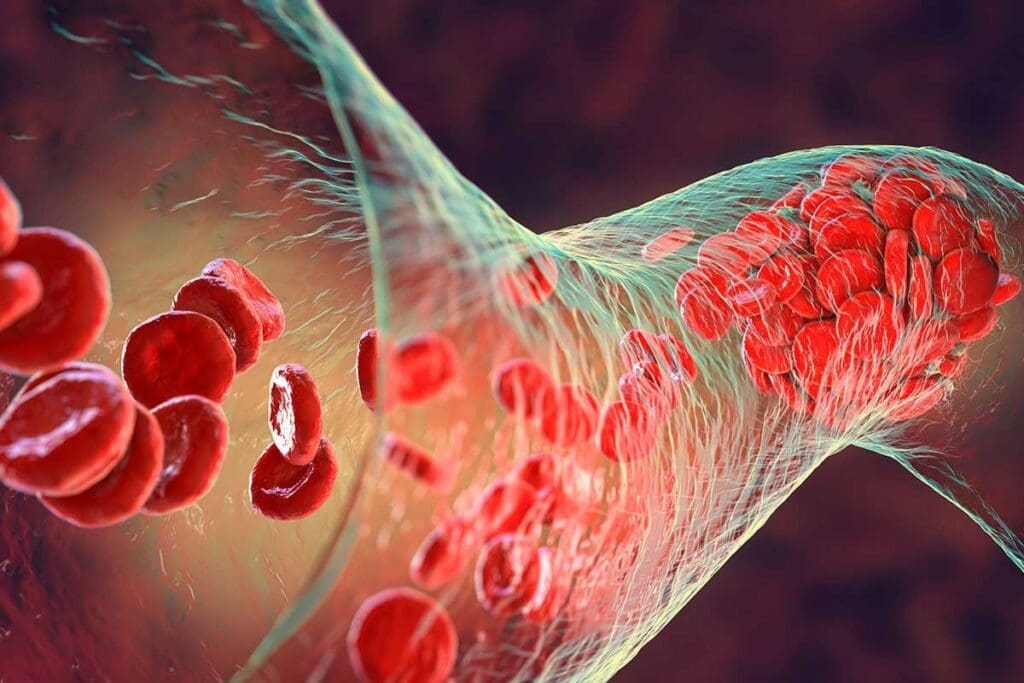Last Updated on November 17, 2025 by Ugurkan Demir

A blood clot in the stomach, also known as an abdominal or mesenteric blood clot, occurs when a thrombus forms in the veins that drain the digestive system. This condition can lead to severe and potentially life-threatening complications if not promptly treated.
It’s important to know the warning signs. Symptoms of blood clots in the stomach include severe abdominal pain, swelling, nausea, vomiting, diarrhea, bloody stools, and bloating. If you notice any of these, seek medical help right away.

A blood clot in the stomach is rare but serious. It happens when a clot forms in the veins draining the digestive system. This can lead to severe health issues.
Mesenteric and abdominal blood clots form in veins draining the intestines and other organs. Mesenteric clots affect the veins of the intestines. These clots can block blood flow, causing tissue damage and serious health risks.
Blood clots in the stomach or abdomen can form due to several factors. These include immobility, cancer, older age, smoking, obesity, and certain chronic diseases. These conditions can lead to slowed blood flow, inflammation, or increased clotting tendency.
Early detection of blood clots in the stomach is key. Timely treatment can greatly improve outcomes. Delayed diagnosis can lead to serious issues like intestinal ischemia, organ damage, and even death. It’s important to recognize symptoms early and seek medical help quickly.
The risk factors for blood clots in the stomach include many elements. Knowing these risks can help prevent them. Being aware of symptoms can also help in early detection.

Severe abdominal pain is often the most alarming symptom that indicates a blood clot in the stomach. Abdominal pain can be a symptom of many conditions. But when it’s related to a blood clot, it can be severe and persistent.
Clot-related abdominal pain often has distinct characteristics. It is typically sharp and intense. It may also be accompanied by a feeling of tightness or pressure in the abdominal area.
The pain can be constant or it may come and go. But it usually persists over time. It can worsen with movement or pressure on the abdomen.
The location of the pain can vary depending on the location of the blood clot within the stomach. Generally, the pain is felt in the central or lower abdomen. In some cases, it may radiate to the back or other areas.
The intensity of the pain can range from mild to severe. It is often described as a sharp, stabbing, or cramping sensation.
Clot-related abdominal pain differs significantly from regular stomach pain. While regular stomach pain may be related to digestion or minor issues, clot-related pain is a sign of a more serious underlying condition.
It’s important to pay attention to the characteristics of the pain. Seek medical attention if it is severe, persistent, or accompanied by other concerning symptoms.
Digestive issues like nausea and vomiting might mean a serious problem, like a blood clot in the stomach. A blood clot can mess with how your stomach works, causing these symptoms.
A blood clot in the stomach can block blood flow to the intestines. This can damage tissue and start an inflammatory response. The body then tries to fight off the perceived danger by causing nausea and vomiting.
The Mechanism Behind Nausea and Vomiting
The process is complex. When a blood clot forms, it can release substances that make you feel sick. These substances can make you feel like vomiting.
The timing and how bad the nausea and vomiting are can tell us a lot. If they start suddenly or are very bad, you should see a doctor right away.
Not every case of nausea and vomiting is because of a blood clot. But some signs are a big warning to see a doctor fast.
| Symptom | Characteristics Indicating a Blood Clot |
| Nausea and Vomiting | Sudden onset, severe, or persistent |
| Vomiting Blood | Presence of blood or coffee ground-like material |
| Abdominal Pain | Severe, localized, or radiating pain |
Knowing about these symptoms can help find and treat blood clots in the stomach early. If you’re feeling very sick, get medical help right away.
Blood in stool is a big warning sign that needs quick medical help, mainly for stomach blood clots. It happens when there’s bleeding in the digestive tract. This could be because of a blood clot blocking blood flow.
Blood in stool shows up in different ways. It’s important to know these signs. It can look like:
Each look can mean different things about where and how much bleeding is happening in the gut.
The color and feel of bloody stools give clues about the bleeding:
| Blood Color | Possible Meaning |
| Bright Red | Bleeding is likely from a lower gastrointestinal source, such as the colon or rectum. |
| Maroon or Dark Red | Indicates bleeding from a higher source, potentially in the small intestine or upper GI tract. |
| Black, Tarry | Suggests upper GI bleeding, as blood has been digested. |
Doctors say ignoring bloody stools is very dangerous. “Gastrointestinal bleeding is a potentially life-threatening condition that requires prompt evaluation and treatment.” Delaying to see a doctor can lead to serious problems, like:
“If gastrointestinal bleeding is not addressed promptly, it can result in significant morbidity and mortality due to blood loss, shock, and the underlying cause of the bleeding.”
So, if you see blood in your stool, get medical help right away. Quick action can make a big difference.
Abdominal swelling and bloating are often seen as minor issues. But they can signal a serious problem like a blood clot in the stomach. These signs happen when there’s inflammation or blockage in the digestive tract, possibly due to a blood clot. Knowing how clots cause swelling is key to spotting and treating them early.
A blood clot in the stomach can block blood flow and digestion. This leads to swelling and bloating. The clot causes inflammation and fluid buildup in the belly. This swelling can press on other organs, making pain worse and possibly causing more serious problems.
Telling normal bloating from clot-related bloating is tricky. Normal bloating usually comes from what you eat or gas. But, bloating from a blood clot is often very painful, with vomiting or bloody stools. If your bloating is bad, lasts a long time, or comes with other scary symptoms, get medical help fast.
“If you’re experiencing persistent or severe abdominal swelling, don’t ignore it. It could be a sign of a serious underlying condition.”
Swelling from a blood clot can turn into a life-threatening emergency if not treated quickly. Look out for severe pain, vomiting blood, or black stools. These signs mean you need urgent medical care to avoid serious harm or death.
Knowing the symptoms of a blood clot stomach is vital. If you or someone you know shows these signs, get help right away. Quick action can greatly improve treatment outcomes for stomach blood clots.
Gastrointestinal issues like diarrhea and bowel changes might mean you have a blood clot in your stomach. You should see a doctor right away. These symptoms happen because the clot messes with how your intestines work.
A blood clot in your stomach can block blood flow to your intestines. This leads to various stomach problems. Without enough blood, your intestines can’t absorb nutrients or handle waste well.
This can cause diarrhea and changes in how often you go to the bathroom. It can also lead to serious issues like bowel ischemia or infarction. These are medical emergencies. So, it’s important to know when your intestines might be in trouble.
Some patterns in bowel changes and diarrhea can mean a blood clot is affecting your intestines. Look out for:
These signs mean the blood clot is really affecting your intestines. It could lead to even more serious problems.
The length of time you have diarrhea and bowel changes, along with other symptoms, is very telling. If diarrhea lasts or gets worse, and you have other symptoms like pain, vomiting, or bloody stools, you need to see a doctor fast.
| Symptom | Characteristics | Potential Indication |
| Diarrhea | Sudden onset, persistent | Vascular compromise |
| Bowel Changes | Alterations in frequency, consistency | Intestinal dysfunction |
| Abdominal Pain | Severe, accompanying bowel changes | Blood clot presence |
Knowing about these symptoms and what they mean can help you get medical help quickly. This might stop serious problems from happening.
A blood clot in the stomach can cause symptoms like unexplained fever and feeling unwell. These signs can mean there’s an inflammation or infection.
When a blood clot forms in the stomach, it can start an inflammatory response. This response includes the release of chemicals that can cause fever and feeling tired. These symptoms should not be ignored, as they may signal a serious condition.
A, a renowned gastroenterologist, notes, “Unexplained fever and general malaise can be the body’s way of responding to a blood clot in the stomach, and it’s important to investigate these symptoms further.”
Fever from a stomach blood clot can be different. It might be mild or severe, depending on the clot and how the body reacts. It’s key to watch the temperature, as an ongoing fever can mean inflammation or infection.
Unexplained fever and feeling unwell, along with other symptoms like abdominal pain or bloody stools, need immediate medical attention. These symptoms together can mean a severe and dangerous condition.
If you’re experiencing these symptoms, it’s vital to seek medical help quickly. Early treatment can greatly improve outcomes for stomach blood clots.
“Prompt medical evaluation is essential for individuals experiencing unexplained fever, general malaise, and other symptoms that could be related to a blood clot in the stomach.”
In conclusion, unexplained fever and feeling unwell are symptoms that should not be ignored. They are important signs of a possible blood clot in the stomach. Knowing these symptoms and getting medical help quickly can save lives.
It’s important to know who might get blood clots in their stomach. This helps in preventing and catching them early. Some people are more likely to get these clots because of certain factors.
Age is a big factor in getting blood clots in the stomach. Older people are more at risk because they move less and have more health problems. Genetic predisposition also plays a part; if your family has a history of blood clots, you might get them too. Gender can also matter, as some conditions are more common in one gender and can lead to clots.
Genetic disorders like Factor V Leiden or Antithrombin III deficiency can greatly raise the risk. These conditions make blood clot more easily.
Some medical conditions can make you more likely to get a blood clot in your stomach. These include:
These conditions can harm blood vessels or change how blood clots, raising the risk.
Lifestyle choices also affect your risk of getting blood clots in your stomach. Smoking and obesity are big risks because they mess with blood flow and clotting. Sitting for long periods, like on flights or in bed, also increases the risk.
Changing these risk factors can help prevent blood clots. This includes:
Spotting risk factors early and taking steps to prevent them can greatly lower the chance of getting a blood clot in the stomach.
Diagnosing and treating blood clots in the stomach is complex. It involves imaging tests and medical treatments. Getting the diagnosis right and fast is key to managing the condition well.
Imaging tests are essential for spotting blood clots in the abdomen. CT scans are often used because they’re very good at finding clots. MRI is also an option when CT scans can’t be used.
Blood tests are also vital in diagnosing blood clots. Tests like D-dimer levels can show if a clot is present. Other tests, like complete blood counts and coagulation profiles, help check how well the blood is clotting.
Treating blood clots in the stomach usually means using both medicine and surgery. Anticoagulation therapy is often started to stop more clots from forming. In serious cases, surgical thrombectomy or catheter-directed thrombolysis might be needed to get blood flowing again.
Acting quickly to diagnose and treat blood clots in the stomach is critical. Knowing the different ways to diagnose and treat helps doctors improve patient care.
To prevent blood clots in the stomach, manage your risk factors and get medical help fast if you have symptoms. Knowing the signs of blood clots in the stomach is key to early treatment.
Prevention includes a healthy lifestyle, managing health conditions, and watching for warning signs. These steps can lower your risk of blood clots.
If you have severe stomach pain, nausea, vomiting, bloody stools, or swelling, get emergency care right away. Quick medical help can greatly improve your chances of recovery from stomach blood clots.
Knowing about blood clots in the stomach symptoms and how to prevent them helps keep you healthy. It also prepares you for emergencies.
A blood clot in the stomach can cause severe pain in the abdomen. You might also feel nauseous and vomit. Other signs include bloody stools, swelling, and changes in bowel movements. You could also have a fever and feel generally unwell.
Yes, a blood clot in the stomach can lead to severe pain. This pain is often intense and can be accompanied by nausea and vomiting.
Clot-related pain is usually more severe and lasts longer than regular stomach pain. It might also come with nausea, vomiting, and bloody stools.
Yes, certain factors can raise your risk. These include age, gender, and genetic predisposition. Medical conditions like cancer and blood-clotting disorders also increase the risk.
Diagnosis involves imaging tests like CT scans and ultrasound. Blood tests and markers are also used to check for clotting and inflammation.
Treatment may include anticoagulation therapy and thrombolysis. Surgery might be needed to remove the clot or repair damaged tissue.
While some risks can’t be changed, lifestyle choices can help. Staying hydrated and managing health conditions can reduce the risk.
If you have severe abdominal pain, bloody stools, or other symptoms, seek emergency care right away.
Yes, a blood clot in the stomach is serious and can be life-threatening if not treated. Quick medical attention is key to preventing complications.
Yes, abdominal pain with blood clots can indicate a blood clot in the stomach. If you notice this, get medical help quickly.
Subscribe to our e-newsletter to stay informed about the latest innovations in the world of health and exclusive offers!